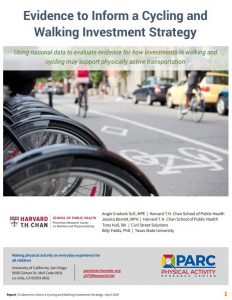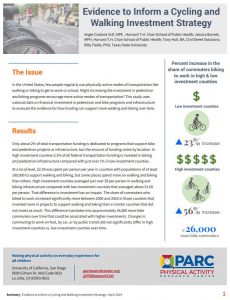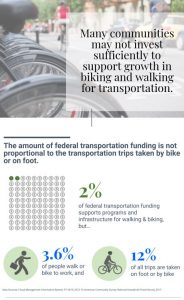Evidence to Inform a Cycling and Walking Investment Strategy
By: Angie Cradock ScD, MPE , Harvard T.H. Chan School of Public Health; Jessica Barrett, MPH, Harvard T.H. Chan School of Public Health; Tony Hull, BA, Civil Street Solutions; Billy Fields, PhD, Texas State University
Originally posted to the Harvard T.H. Chan School of Public Health website.
In the United States, few people regularly use physically active modes of transportation like walking or cycling to get to work or school. Might increasing the investment in pedestrian and cycling programs encourage more active modes of transportation? This study uses national data on financial investment in pedestrian and bicycle programs and infrastructure to evaluate the evidence for how funding can support more walking and cycling over time.
This study used data from the U.S. Census and the American Community Survey to look at how people ages 16 and older got to and from work over time between 2000 and 2016 in counties with populations of at least 100,000 people. The authors calculated how much total federal transportation funding was used to support projects for cycling and walking in all U.S. counties from 2000 and 2015, classifying some as high investment counties and others as low investment counties. Authors looked in depth at data from 104 counties. High investment counties spent five to six times as much as low-investment counties did on bicycle and pedestrian projects. The researchers then analyzed these data to determine changes over time in the proportion of workers traveling on foot or bicycle within both low investment and high investment counties.
Key findings from the study included:
- Nationally, the proportion of total federal transportation funding allocated specifically for cycling and pedestrian investments has increased over time from 0.1% of total transportation funding allocation in FY 1992 to 2.2% of total transportation funding allocation in FY 2015.
- Locally, the allocation and use of federal funding for cycling and pedestrian investments is variable across counties in the U.S.
- The share of commuters cycling to work increased on average in counties between 2000 and 2016.
- The increases were greater in those counties with high levels of bicycle and pedestrian funding compared to counties with low levels of funding.
In conclusion, many communities may not invest sufficiently to support growth in cycling and walking for transportation, recreation or exercise. Federal funding for bicycle and pedestrian projects can play a role in increasing the proportion of workers using a bicycle to get to and from work.
The findings in this research summary are based on the results of a project commissioned by the Physical Activity Research Center (PARC) focused on addressing research gaps related to policies aimed at helping children achieve a healthy weight.
Suggested Citation:
Cradock AL, Barrett J, Hull T, Fields W. Evidence to Inform a Cycling and Walking Investment Strategy. Boston, MA: Prevention Research Center on Nutrition and Physical Activity at the Harvard T.H. Chan School of Public Health; 2019. Available at: https://www.hsph.harvard.edu/prc/projects/communities-research/evidence-to-inform-a-cycling-and-walking-investment-strategy.
Address correspondence to Angie Cradock, ScD, MPE at [email protected].



